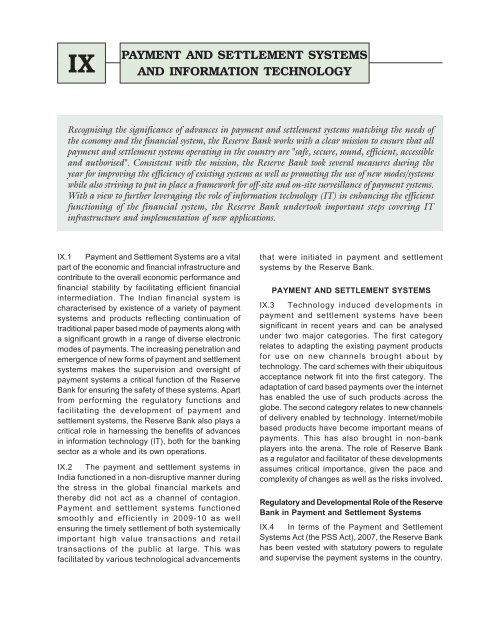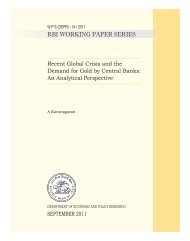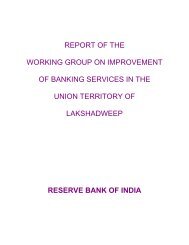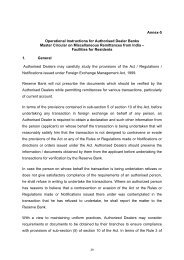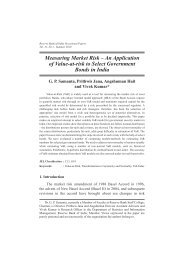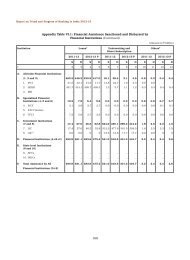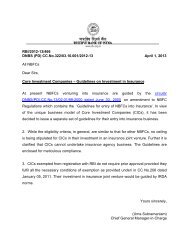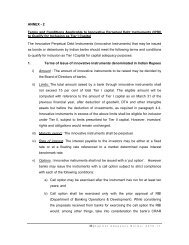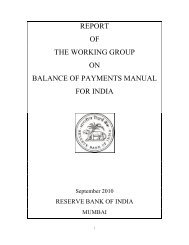payment and settlement systems and information ... - RBI Website
payment and settlement systems and information ... - RBI Website
payment and settlement systems and information ... - RBI Website
You also want an ePaper? Increase the reach of your titles
YUMPU automatically turns print PDFs into web optimized ePapers that Google loves.
IX<br />
PAYMENT AND SETTLEMENT SYSTEMS<br />
AND INFORMATION TECHNOLOGY<br />
Recognising the significance of advances in <strong>payment</strong> <strong>and</strong> <strong>settlement</strong> <strong>systems</strong> matching the needs of<br />
the economy <strong>and</strong> the financial system, the Reserve Bank works with a clear mission to ensure that all<br />
<strong>payment</strong> <strong>and</strong> <strong>settlement</strong> <strong>systems</strong> operating in the country are "safe, secure, sound, efficient, accessible<br />
<strong>and</strong> authorised". Consistent with the mission, the Reserve Bank took several measures during the<br />
year for improving the efficiency of existing <strong>systems</strong> as well as promoting the use of new modes/<strong>systems</strong><br />
while also striving to put in place a framework for off-site <strong>and</strong> on-site surveillance of <strong>payment</strong> <strong>systems</strong>.<br />
With a view to further leveraging the role of <strong>information</strong> technology (IT) in enhancing the efficient<br />
functioning of the financial system, the Reserve Bank undertook important steps covering IT<br />
infrastructure <strong>and</strong> implementation of new applications.<br />
IX.1 Payment <strong>and</strong> Settlement Systems are a vital<br />
part of the economic <strong>and</strong> financial infrastructure <strong>and</strong><br />
contribute to the overall economic performance <strong>and</strong><br />
financial stability by facilitating efficient financial<br />
intermediation. The Indian financial system is<br />
characterised by existence of a variety of <strong>payment</strong><br />
<strong>systems</strong> <strong>and</strong> products reflecting continuation of<br />
traditional paper based mode of <strong>payment</strong>s along with<br />
a significant growth in a range of diverse electronic<br />
modes of <strong>payment</strong>s. The increasing penetration <strong>and</strong><br />
emergence of new forms of <strong>payment</strong> <strong>and</strong> <strong>settlement</strong><br />
<strong>systems</strong> makes the supervision <strong>and</strong> oversight of<br />
<strong>payment</strong> <strong>systems</strong> a critical function of the Reserve<br />
Bank for ensuring the safety of these <strong>systems</strong>. Apart<br />
from performing the regulatory functions <strong>and</strong><br />
facilitating the development of <strong>payment</strong> <strong>and</strong><br />
<strong>settlement</strong> <strong>systems</strong>, the Reserve Bank also plays a<br />
critical role in harnessing the benefits of advances<br />
in <strong>information</strong> technology (IT), both for the banking<br />
sector as a whole <strong>and</strong> its own operations.<br />
IX.2 The <strong>payment</strong> <strong>and</strong> <strong>settlement</strong> <strong>systems</strong> in<br />
India functioned in a non-disruptive manner during<br />
the stress in the global financial markets <strong>and</strong><br />
thereby did not act as a channel of contagion.<br />
Payment <strong>and</strong> <strong>settlement</strong> <strong>systems</strong> functioned<br />
smoothly <strong>and</strong> efficiently in 2009-10 as well<br />
ensuring the timely <strong>settlement</strong> of both systemically<br />
important high value transactions <strong>and</strong> retail<br />
transactions of the public at large. This was<br />
facilitated by various technological advancements<br />
that were initiated in <strong>payment</strong> <strong>and</strong> <strong>settlement</strong><br />
<strong>systems</strong> by the Reserve Bank.<br />
PAYMENT AND SETTLEMENT SYSTEMS<br />
IX.3 Technology induced developments in<br />
<strong>payment</strong> <strong>and</strong> <strong>settlement</strong> <strong>systems</strong> have been<br />
significant in recent years <strong>and</strong> can be analysed<br />
under two major categories. The first category<br />
relates to adapting the existing <strong>payment</strong> products<br />
for use on new channels brought about by<br />
technology. The card schemes with their ubiquitous<br />
acceptance network fit into the first category. The<br />
adaptation of card based <strong>payment</strong>s over the internet<br />
has enabled the use of such products across the<br />
globe. The second category relates to new channels<br />
of delivery enabled by technology. Internet/mobile<br />
based products have become important means of<br />
<strong>payment</strong>s. This has also brought in non-bank<br />
players into the arena. The role of Reserve Bank<br />
as a regulator <strong>and</strong> facilitator of these developments<br />
assumes critical importance, given the pace <strong>and</strong><br />
complexity of changes as well as the risks involved.<br />
Regulatory <strong>and</strong> Developmental Role of the Reserve<br />
Bank in Payment <strong>and</strong> Settlement Systems<br />
IX.4 In terms of the Payment <strong>and</strong> Settlement<br />
Systems Act (the PSS Act), 2007, the Reserve Bank<br />
has been vested with statutory powers to regulate<br />
<strong>and</strong> supervise the <strong>payment</strong> <strong>systems</strong> in the country.
Under the PSS Act, the Bank has constituted an apex<br />
body, the Board for Regulation <strong>and</strong> Supervision of<br />
Payment <strong>and</strong> Settlement Systems (BPSS). The<br />
Department of Payment <strong>and</strong> Settlement Systems<br />
(DPSS) of the Reserve Bank assists the BPSS in<br />
administering various provisions of the PSS Act.<br />
IX.5 The PSS Act enjoins upon any entity the<br />
need to obtain authorisation from the Bank (unless<br />
specifically exempted in terms of the PSS Act) for<br />
operating any <strong>payment</strong> system as defined therein.<br />
By the end of June 2010, authorisation has been<br />
granted to 37 <strong>payment</strong> system operators of prepaid<br />
<strong>payment</strong> instruments, card schemes, cross<br />
border inward money transfers, Automated Teller<br />
Machine (ATM) networks <strong>and</strong> centralised clearing<br />
arrangements. The details of authorised entities are<br />
available on the Reserve Bank’s website<br />
(www.rbi.org.in). All <strong>payment</strong> system operators<br />
ANNUAL REPORT<br />
134<br />
have been advised to comply with the relevant Anti<br />
Money Laundering (AML) st<strong>and</strong>ards <strong>and</strong> Combating<br />
Financing of Terrorism (CFT) guidelines issued by<br />
the Bank.<br />
Developments in Payment <strong>and</strong> Settlement Systems<br />
IX.6 The total turnover under various <strong>payment</strong><br />
<strong>and</strong> <strong>settlement</strong> <strong>systems</strong> registered a growth of 15.6<br />
per cent in terms of value during 2009-10, as compared<br />
with 13.3 per cent during 2008-09 (Table IX.1). The<br />
annual turnover in <strong>payment</strong> <strong>systems</strong> has been<br />
increasing as a ratio of GDP which is consistent<br />
with the financial deepening of the economy.<br />
Paper-based Payment Systems:<br />
IX.7 The paper-based <strong>systems</strong> still continue to<br />
dominate in terms of volume, <strong>and</strong> therefore are<br />
Table IX.1 : Payment System Indicators - Annual Turnover<br />
Item Volume (000s) Value (Rupees crore)<br />
2007-08 2008-09 2009-10 2007-08 2008-09 2009-10<br />
1 2 3 4 5 6 7<br />
Systemically Important Payment Systems (SIPS)<br />
1. High Value Clearing 21,919 21,848 5,525 55,00,018 45,50,667 18,61,560<br />
2. RTGS 5,840 13,366 33,241 2,73,18,330 3,22,79,881 3,94,53,359<br />
Total SIPS (1+2) 27,759 35,214 38,766 3,28,18,348 3,68,30,548 4,13,14,919<br />
Financial Markets Clearing<br />
(6.6) (6.6) (6.6)<br />
3. CBLO 113 119 142 81,10,829 88,24,784 1,55,41,378<br />
4. Government Securities Clearing 216 270 346 56,02,602 62,54,519 89,86,718<br />
5. Forex Clearing. 757 838 884 1,27,26,832 1,69,37,489 1,42,11,486<br />
Total Financial Markets Clearing (3 to 5) 1,086 1,227 1,372 2,64,40,263 3,20,16,792 3,87,39,582<br />
Others<br />
(5.3) (5.7) (6.2)<br />
6. MICR Clearing 12,01,045 11,40,492 11,43,164 60,28,672 58,49,642 66,64,003<br />
7. Non-MICR Clearing 2,37,600 2,33,566 2,30,567 18,67,376 20,60,893 18,78,425<br />
Retail Electronic Clearing<br />
8. ECS DR 1,27,120 1,60,055 1,50,214 48,937 66,976 69,819<br />
9. ECS CR 78,365 88,394 98,550 7,82,222 97,487 1,17,833<br />
10. EFT/NEFT 13,315 32,161 66,357 1,40,326 2,51,956 4,11,088<br />
Total Retail Electronic Clearing Cards 2,18,800 2,80,610 3,15,121 9,71,485 4,16,419 5,98,740<br />
11. Credit Cards 2,28,208 2,59,561 2,34,209 57,985 65,356 62,950<br />
12. Debit Cards 88,306 1,27,654 1,70,170 12,521 18,547 26,566<br />
Total Others (6 to 12) 19,73,954 20,41,883 20,93,231 89,38,039 84,10,857 92,30,684<br />
(1.8) (1.5) (1.5)<br />
Gr<strong>and</strong> Total (1 to 12) 20,02,799 20,78,324 21,33,369 6,81,96,650 7,72,58,197 8,92,85,185<br />
(13.8) (13.9) (14.3)<br />
Notes: 1. High value clearing refers to cheques of `1 lakh/10 lakh. The clearing has been discontinued with effect from April 1, 2010.<br />
2. Settlement of government securities clearing, CBLO <strong>and</strong> forex transactions is through Clearing Corporation of India Ltd.<br />
3. At the end of April 2010, the MICR clearing was available at 66 centres (65 centres during previous year).<br />
4. The figures relates to Cards are for transactions at POS Terminals only.<br />
5. Figures in parentheses are ratios to GDP at current market prices.<br />
6. Retail Electronic Clearing for 2007-08 (Volume <strong>and</strong> Value) includes refund of the oversubscription amount of IPOs floated by companies using<br />
electronic mode by the stock exchanges as m<strong>and</strong>ated.
categorised as a System-Wide Important Payment<br />
System (SWIPS). Its share has, however, been<br />
declining both in volume <strong>and</strong> value terms in recent<br />
years (Chart IX.1). To streamline the process <strong>and</strong><br />
reduce the time taken for collection of outstation<br />
cheques, the concept of Speed Clearing (introduced<br />
in 2008, leveraging on the core banking infrastructure<br />
of banks) has now been made available as part of<br />
Magnetic Ink Character Recognition (MICR) clearing<br />
at all the 66 MICR Cheque Processing Centres<br />
(CPCs). This has reduced the time taken for<br />
realisation of proceeds of outstation cheques to<br />
T+2/ 3 days. As a consequence, the separate intercity<br />
clearing run by Reserve Bank was discontinued<br />
from November 2009.<br />
IX.8 To ensure further efficiency as also to reduce<br />
physical movement of cheques, the Cheque<br />
Truncation System (CTS) that involves use of images<br />
for processing of cheques in clearing was introduced<br />
in the National Capital Region (NCR) of Delhi in 2008.<br />
With complete migration of cheque volume to CTS,<br />
the MICR processing has been discontinued in the<br />
NCR. The CTS system now h<strong>and</strong>les around 12 per<br />
cent of the total cheque volume in the country. In a<br />
bid to extend the benefit of CTS to other parts of the<br />
country, the process of roll-out of CTS at Chennai<br />
has been initiated. A grid-based approach is being<br />
envisaged as part of the roll-out process whereby all<br />
the centres in a region can reap the benefits of CTS<br />
by joining the arrangements.<br />
IX.9 After a comprehensive review <strong>and</strong><br />
discussions with stakeholders, a new cheque<br />
PAYMENT AND SETTLEMENT SYSTEMS AND<br />
INFORMATION TECHNOLOGY<br />
135<br />
st<strong>and</strong>ard styled ‘CTS-2010 St<strong>and</strong>ard’ prescribing<br />
m<strong>and</strong>atory <strong>and</strong> desirable security features on<br />
cheque forms/leafs has been proposed, which<br />
would further increase the comfort of banks<br />
while using images for presenting <strong>and</strong> processing<br />
(Box IX.1). This is expected to be implemented in a<br />
phased manner starting early 2011.<br />
IX.10 Considering the inherent risks involved <strong>and</strong><br />
as an important step towards encouraging transition<br />
to alternate efficient electronic <strong>payment</strong> <strong>systems</strong><br />
viz. RTGS, NEFT, the Reserve Bank discontinued<br />
the separate High Value Clearing (HVC) (i.e., same<br />
day clearing of local cheques of `1 lakh <strong>and</strong> above),<br />
that was operational at 30 large centres across the<br />
country, in a non-disruptive manner. Cheques of<br />
higher value can, however, continue to be<br />
presented in the normal MICR clearing.<br />
Electronic Payment Systems<br />
IX.11 The Reserve Bank has been, over a period<br />
of time, proactively encouraging the introduction<br />
of electronic <strong>payment</strong> products that are superior to<br />
paper-based <strong>systems</strong> in terms of traceability,<br />
efficiency, speed <strong>and</strong> safety. These include large<br />
value <strong>payment</strong> options like the Real Time Gross<br />
Settlement (RTGS) as also retail <strong>payment</strong> options<br />
that facilitate multiple credit/debit transactions<br />
(Electronic Clearing Service (ECS) - credit/debit)<br />
or person to person electronic <strong>payment</strong>s (National<br />
Electronic Funds Transfer - NEFT).
The developments in cheque clearing, such as growing<br />
use of multi-city <strong>and</strong> payable-at-par cheques, introduction<br />
of Cheque Truncation System (CTS) for image-based<br />
cheque processing, <strong>and</strong> increasing popularity of Speed<br />
Clearing for local processing of outstation cheques have<br />
increased complexity in cheque processing which calls for<br />
process re-engineering <strong>and</strong> automation. Such<br />
developments along with the diversity in patterns, designs<br />
<strong>and</strong> security features of cheque forms introduced over a<br />
period of time have necessitated prescription of certain<br />
minimum security features in cheques printed, issued <strong>and</strong><br />
h<strong>and</strong>led by banks for uniform application across the<br />
banking industry. Against this backdrop, a Working Group<br />
comprising various stakeholders viz., commercial banks,<br />
paper manufacturers <strong>and</strong> security printers apart from<br />
Reserve Bank was set-up by the Bank for examining the<br />
need for further st<strong>and</strong>ardisation of cheque forms <strong>and</strong><br />
enhancement of security features therein.<br />
Based on the recommendations of the Working Group <strong>and</strong><br />
the feedback received from banks, Indian Banks<br />
Association (IBA) <strong>and</strong> National Payments Corporation of<br />
India (NPCI) among others, certain benchmarks towards<br />
st<strong>and</strong>ardisation of cheques have been issued. The<br />
benchmarks styled “CTS-2010 st<strong>and</strong>ard” contains<br />
m<strong>and</strong>atory <strong>and</strong> optional security features on cheque forms.<br />
The m<strong>and</strong>atory security features include quality of security<br />
paper, “CTS-INDIA” watermark, bank’s logo in invisible ink<br />
(UV ink) <strong>and</strong> void pantograph (an anti-copying feature).<br />
a) A new variant of ECS styled National<br />
Electronic Clearing Service (NECS) was<br />
introduced in September 2008, to overcome<br />
the geographical limitations of the coverage<br />
of the current ECS, which was available only<br />
at 86 major centres, <strong>and</strong> to enable users to<br />
avoid submission of multiple files to different<br />
centres. NECS facilitates participation of all<br />
Core Banking Solution (CBS) enabled<br />
branches of member banks. The processing<br />
<strong>and</strong> <strong>settlement</strong> of NECS is centralised at<br />
Mumbai. As a further refinement, to cater to<br />
the need of banks operating at the State/<br />
Regional level, Regional ECS (RECS) credit<br />
was introduced on a pilot basis in Bangalore<br />
in May 2009. RECS operates from a single<br />
location in the State (the capital city) <strong>and</strong><br />
credits are made to beneficiary accounts<br />
maintained with core-banking enabled branches<br />
across the entire State. This has since been<br />
ANNUAL REPORT<br />
Box IX.1<br />
New Cheque St<strong>and</strong>ard “CTS 2010”<br />
136<br />
Additionally, certain desirable features have also been<br />
suggested, which could be implemented by banks based<br />
on their needs <strong>and</strong> their own risk perception. The new<br />
cheque st<strong>and</strong>ard m<strong>and</strong>ates placement of significant fields<br />
on the cheque forms. It also recommends use of light/pastel<br />
colours <strong>and</strong> clutter free background in cheque forms for<br />
improving quality <strong>and</strong> content of cheque images in CTS<br />
scenario. The benchmarks, inter alia, include prohibition<br />
of alterations/corrections on cheque forms other than for<br />
date validation. Use of UV image view in CTS has been<br />
kept on hold for the present considering the implementation<br />
challenges <strong>and</strong> will be reviewed in future.<br />
This set of minimum security features would not only<br />
ensure uniformity across all cheque forms issued by banks<br />
in the country, but also aid presenting/collecting banks<br />
while scrutinising/recognising cheques of drawee banks<br />
in an image-based processing scenario. The homogeneity<br />
in security features is expected to act as a deterrent against<br />
cheque frauds, while the st<strong>and</strong>ardisation of field<br />
placements on cheque forms would enable straightthrough-processing<br />
by use of optical/image character<br />
recognition technology. The “CTS-2010 st<strong>and</strong>ard” is<br />
proposed to be implemented by banks before the roll-out<br />
of CTS at Chennai. IBA <strong>and</strong> NPCI have been vested with<br />
the responsibility to co-ordinate <strong>and</strong> advise banks on<br />
introduction of additional security features on cheques as<br />
also other aspects relating to implementation of the new<br />
st<strong>and</strong>ard across the country.<br />
extended to Chennai <strong>and</strong> is proposed to be<br />
operationalised across the country.<br />
b) The NEFT system has been strengthened by:<br />
(i) enhancing Business Continuity Plans/<br />
Disaster Recovery arrangements, ii)<br />
m<strong>and</strong>ating creation of Customer Facilitation<br />
Centre (CFC) for prompt resolution of customer<br />
complaints, (iii) increasing the number of<br />
<strong>settlement</strong>s from six to eleven <strong>and</strong> making the<br />
system available from 0900 hours to 1900<br />
hours on weekdays <strong>and</strong> 0900 hours to 1300<br />
hours on Saturdays <strong>and</strong> (iv) m<strong>and</strong>ating ‘Positive<br />
Confirmation’ to be sent to the originator<br />
confirming successful credit to beneficiary’s<br />
account. NEFT is presently available across over<br />
69,000 branches in the country.<br />
c) The scope <strong>and</strong> coverage of RTGS was<br />
exp<strong>and</strong>ed by (i) permitting SEBI regulated<br />
clearing entities to settle funds leg of OTC
trades of the corporate bond transactions in<br />
RTGS, since December 2009, <strong>and</strong> (ii) extending<br />
the cut-off time for processing customer<br />
transactions in RTGS at the Reserve Bank up<br />
to 1630 hours on weekdays <strong>and</strong> 1330 hours on<br />
Saturdays. Accordingly, the cut-off time for<br />
processing inter-bank transactions was<br />
extended up to 1800 hours on weekdays <strong>and</strong><br />
1500 hours on Saturdays. It is expected that<br />
banks would, in turn, correspondingly facilitate<br />
longer cut off time to their customers for putting<br />
through transactions in RTGS.<br />
IX.12 The RTGS system has been in operation in<br />
India since March 2004 <strong>and</strong> has been exhibiting<br />
rapid growth, not only in terms of volume <strong>and</strong> value<br />
of transactions but also in the coverage of branches<br />
(Chart IX.2). During the year 2009-10, a total of<br />
11,172 bank branches were added in the RTGS<br />
system, thereby increasing the number of RTGS<br />
enabled bank branches to 66,178. The efficiency<br />
of RTGS system can be judged from the peak<br />
volume of RTGS transactions, which touched 248<br />
thous<strong>and</strong> transactions on March 30, 2010 as<br />
compared to the last year’s peak level of 128<br />
thous<strong>and</strong> transactions on March 29, 2009. The<br />
increased volumes could be h<strong>and</strong>led smoothly as<br />
the Reserve Bank upgraded central <strong>systems</strong> at Data<br />
Centre in December 2009 by implementing<br />
architectural changes in the RTGS application.<br />
IX.13 Considering the importance of RTGS for<br />
settling the large value <strong>payment</strong>s, the Reserve<br />
PAYMENT AND SETTLEMENT SYSTEMS AND<br />
INFORMATION TECHNOLOGY<br />
137<br />
Bank has initiated steps to revamp the current<br />
RTGS system. The proposed system would improve<br />
technological <strong>and</strong> liquidity saving features at par<br />
with the similar <strong>systems</strong> operating elsewhere in the<br />
world. A Working Group comprising representatives<br />
from the Reserve Bank <strong>and</strong> major commercial<br />
banks has been constituted for preparing the basic<br />
approach towards a next generation RTGS system,<br />
both from the business <strong>and</strong> IT perspective.<br />
Emerging Payment Channels<br />
IX.14 Advances in Information Technology have<br />
brought about significant changes in <strong>payment</strong><br />
channels available across the globe. In India too,<br />
while card based <strong>payment</strong>s have been in use for<br />
quite some time, more recently, internet/mobile<br />
phone based products <strong>and</strong> the use of these<br />
channels for transactions have been gaining<br />
momentum <strong>and</strong> popularity. Further variations of<br />
cards like the pre-paid cards also have emerged.<br />
The challenge to the Reserve Bank as a regulator<br />
posed by such developments is to strike the right<br />
balance between encouraging innovations <strong>and</strong><br />
protecting the integrity <strong>and</strong> safety of the <strong>payment</strong><br />
system <strong>and</strong> upholding the interests of the users.<br />
Within this broad framework, the Reserve Bank<br />
took several initiatives to encourage the orderly<br />
development of these <strong>payment</strong> channels.<br />
IX.15 To mitigate the risks arising out of the use<br />
of credit/debit cards over internet/IVRS (technically<br />
referred to as card not present (CNP) transactions),
it was m<strong>and</strong>ated that all CNP transactions should<br />
be additionally authenticated based on <strong>information</strong><br />
not available on the card <strong>and</strong> an online alert should<br />
be sent to the cardholders for such transactions of<br />
value for `5,000 <strong>and</strong> above.<br />
IX.16 Pre-paid <strong>payment</strong> instruments facilitate<br />
purchase of goods <strong>and</strong> services against the value<br />
stored on such instruments. To bring in<br />
transparency <strong>and</strong> facilitate orderly growth of this<br />
<strong>payment</strong> product, the Bank issued guidelines in<br />
April 2009 <strong>and</strong> August 2009 on issuance <strong>and</strong><br />
operations of pre-paid <strong>payment</strong> instruments. 25<br />
banks <strong>and</strong> 12 non-banks have so far been accorded<br />
approval for issuing pre-paid cards.<br />
IX.17 The operating guidelines for mobile banking<br />
issued in October 2008 were relaxed in December<br />
2009, facilitating mobile banking transactions up to<br />
`50,000, both for e-commerce <strong>and</strong> money transfer<br />
purposes. Banks have also been permitted to<br />
provide money transfer facility up to `5,000 from a<br />
bank account to beneficiaries not having bank<br />
accounts with cash payout facility at an ATM or<br />
Banking Correspondent. Till June 30, 2010, 40<br />
banks have been granted approval for providing<br />
mobile banking facility.<br />
Customer Service<br />
IX.18 Any efficient <strong>payment</strong> system has to<br />
effectively address the customer service issues<br />
relating to ease <strong>and</strong> cost of access, safety of funds<br />
<strong>and</strong> compensation. The Reserve Bank undertook<br />
several important measures in this direction.<br />
(a) To effectively address the customer service<br />
issues arising out of failed ATM transactions<br />
where the customer’s account gets debited<br />
without actual disbursal of cash, the Reserve<br />
Bank issued directive to banks in July 2009.<br />
The directives re-iterated that the 12 working<br />
day time limit be adhered to for re-crediting of<br />
such failed transactions <strong>and</strong> m<strong>and</strong>ating<br />
compensation of `100 per day for delays<br />
beyond the stipulated period. Banks were also<br />
advised to submit periodical reports to their<br />
Board detailing penalty <strong>payment</strong>s. Furthermore,<br />
a st<strong>and</strong>ardised template was prescribed for<br />
ANNUAL REPORT<br />
138<br />
being displayed at all ATM locations to facilitate<br />
lodging of complaints by customers.<br />
(b) Recognising the fact that the number of Points<br />
of Sale (PoS) terminals in the country is over<br />
8 times the number of ATMs <strong>and</strong> the need for<br />
increasing the number of outlets for currency<br />
dispensation to enhance customer<br />
convenience, the Bank has permitted cash<br />
withdrawal up to `1,000 using debit cards at<br />
PoS terminals. So far, four banks have been<br />
accorded permission to introduce this facility.<br />
(c) The use of electronic/online mode of<br />
<strong>payment</strong>s for purchase of goods <strong>and</strong> services<br />
<strong>and</strong> making <strong>payment</strong>s to public utility<br />
companies is becoming increasingly popular.<br />
This involves intermediaries like aggregators<br />
<strong>and</strong> <strong>payment</strong> gateway service providers<br />
h<strong>and</strong>ling customer funds. To ensure the safety<br />
of customer funds involved, guidelines were<br />
issued in November 2009, which inter-alia<br />
prohibit the use of such funds by these<br />
intermediaries <strong>and</strong> require the banks holding<br />
these balances to ensure timely onward<br />
<strong>settlement</strong> of funds to public utility companies/<br />
merchants.<br />
International Co-operation/Co-ordination:<br />
IX.19 In July 2009, the Committee on Payment<br />
<strong>and</strong> Settlement Systems (CPSS), constituted under<br />
the aegis of the Bank for International Settlements<br />
(BIS), exp<strong>and</strong>ed its membership <strong>and</strong> India has been<br />
included as one of the members. The CPSS serves<br />
as a forum for central banks to monitor <strong>and</strong> analyse<br />
developments in domestic <strong>payment</strong>, <strong>settlement</strong> <strong>and</strong><br />
clearing <strong>systems</strong> as well as in cross-border <strong>and</strong><br />
multi-currency <strong>settlement</strong> schemes. The Reserve<br />
Bank is also represented on four Working Groups<br />
of CPSS set-up for drawing of st<strong>and</strong>ards/guidelines<br />
towards efficient functioning of <strong>payment</strong> <strong>and</strong><br />
<strong>settlement</strong> <strong>systems</strong> <strong>and</strong> supporting market<br />
infrastructures across the world. India is also a<br />
member of the SAARC Payments Council. Under<br />
the SAARC initiatives, the Reserve Bank has been<br />
assisting Royal Monetary Authority (RMA) of<br />
Bhutan in setting up the retail electronic <strong>payment</strong><br />
<strong>systems</strong>.
Payment System Vision<br />
IX.20 Following the enactment of the PSS Act,<br />
the Reserve Bank with directions from the BPSS<br />
has suitably enhanced its Mission statement, “to<br />
ensure that all the <strong>payment</strong> <strong>and</strong> <strong>settlement</strong> <strong>systems</strong><br />
operating in the country are safe, secure, sound,<br />
efficient, accessible <strong>and</strong> authorised”. Towards<br />
achieving this Mission, a document for 2009-12 with<br />
definite targets has been prepared. The Bank in<br />
the short <strong>and</strong> medium term will endeavour to<br />
enhance the security, integrity <strong>and</strong> resilience of the<br />
<strong>payment</strong> system infrastructure in the country.<br />
Towards this, the Bank is in the process of putting<br />
in place a framework for off-site <strong>and</strong> on-site<br />
surveillance of <strong>payment</strong> <strong>systems</strong>.<br />
IX.21 Remaining challenges include: (i)<br />
implementing Cheque Truncation System at National<br />
level, (ii) reviewing RECS (Credit <strong>and</strong> Debit) <strong>and</strong><br />
integrating with NECS (Credit <strong>and</strong> Debit), (iii)<br />
guiding the expansion of NPCI activities to introduce<br />
IndiaCard, POS Switch <strong>and</strong> Mobile Payments<br />
Settlement Network <strong>and</strong> (iv) developing Next-Gen<br />
RTGS.<br />
IX.22 The borderless nature of internet has<br />
resulted in <strong>payment</strong> service providers, authorised<br />
in one or few countries, extending their <strong>payment</strong><br />
services to customers of other countries. These<br />
entities, which provide cross border <strong>payment</strong>s,<br />
money transfer <strong>and</strong> stored value accounts facilitate,<br />
flow of funds in/out of the country, <strong>and</strong> also pool<br />
the funds due to customers of the country in<br />
accounts outside the country, which can militate<br />
against legal/regulatory requirements of a country<br />
where the capital account is not fully convertible.<br />
This also poses challenges in ensuring compliance<br />
with the AML/CFT requirements of the country.<br />
Furthermore, as most of these arrangements are<br />
often unregulated <strong>and</strong> operated from outside the<br />
country, the customers of the country would have<br />
no recourse on failure of such entities to deliver their<br />
services or winding-up of operations by these<br />
entities. The challenge for the Reserve Bank, in such<br />
a scenario, is in ensuring that while authorised<br />
<strong>payment</strong> <strong>systems</strong>/entities are enabled to function<br />
smoothly, the unauthorised entities are identified <strong>and</strong><br />
mitigating measures are taken in a timely manner.<br />
PAYMENT AND SETTLEMENT SYSTEMS AND<br />
INFORMATION TECHNOLOGY<br />
139<br />
INFORMATION TECHNOLOGY<br />
IX.23 Information Technology (IT) has helped in<br />
increasing the speed <strong>and</strong> efficiency of banking<br />
operations by facilitating the emergence of<br />
innovative products <strong>and</strong> new delivery channels. The<br />
role of the Reserve Bank as the driver of technology<br />
initiatives in the banking sector assumes greater<br />
importance given the challenges posed by rapid<br />
advancements in technology. In an environment of<br />
fast changing trends <strong>and</strong> ever increasing dem<strong>and</strong>s<br />
of users, IT adoption poses several challenges,<br />
spanning applications, security, network, vendor<br />
management <strong>and</strong> data management.<br />
IX.24 During 2009-10, the Reserve Bank<br />
undertook a number of initiatives in improving IT<br />
infrastructure facilities, implementing new<br />
applications <strong>and</strong> initiating steps for further adoption<br />
of technology in the financial sector.<br />
Information Technology Infrastructure<br />
IX.25 As availability of quality IT infrastructure is<br />
the prerequisite for adoption of technology in the<br />
financial sector, the Reserve Bank has been<br />
constantly working towards making significant<br />
improvements in the IT infrastructure.<br />
Data Centres: The Reserve Bank has set up three<br />
data centres for running systemically important<br />
<strong>payment</strong> <strong>and</strong> <strong>settlement</strong> system for the financial<br />
sector <strong>and</strong> also its internal applications. All the three<br />
data centres are running on a 24X7 basis. Apart<br />
from ensuring smooth running of applications (relating<br />
to both <strong>payment</strong> <strong>and</strong> non-<strong>payment</strong> <strong>systems</strong>), the data<br />
centres provide enhanced assurance for business<br />
continuity. During 2009-10, Disaster Recovery (DR)<br />
drills were conducted for <strong>payment</strong> <strong>and</strong> <strong>settlement</strong><br />
system applications as well as non-<strong>payment</strong> related<br />
applications at periodical intervals.<br />
Networks: Indian Financial Network (INFINET), a<br />
closed user group communication backbone for the<br />
Indian financial sector set up by the Institute for<br />
Development <strong>and</strong> Research in Banking Technology<br />
(IDRBT), continues to provide secured connectivity<br />
for accessing all <strong>payment</strong> <strong>and</strong> <strong>settlement</strong> system<br />
applications.
Secured Internet <strong>Website</strong>: This is a single web based<br />
interface for connecting banks <strong>and</strong> government<br />
entities with the Reserve Bank over the internet. It<br />
provides for secured exchange of <strong>information</strong><br />
between the Reserve Bank <strong>and</strong> other external<br />
agencies. Among various utilities, this site is being<br />
used for Online Returns Filing System (ORFS) by<br />
banks, Complaint Tracking System related to Banking<br />
Ombudsman scheme, <strong>and</strong> sharing of MICR/ECS<br />
data by banks <strong>and</strong> clearing houses.<br />
Information Technology Applications<br />
IX.26 IT Applications managed by the Reserve<br />
Bank can be classified into three categories: (i)<br />
Payment <strong>and</strong> Settlement System Applications, (ii)<br />
Non-<strong>payment</strong> System Applications <strong>and</strong> (iii)<br />
Applications for internal users of the Reserve Bank.<br />
Among Payment <strong>and</strong> Settlement Systems related<br />
applications, Real Time Gross Settlement (RTGS) <strong>and</strong><br />
Public Debt Office-Negotiated Dealing System (PDO-<br />
NDS) are used across the financial sector, whereas<br />
Integrated Accounting System (IAS) <strong>and</strong> Centralised<br />
Public Accounts Department System (CPADS) are<br />
used by various departments of the Reserve Bank.<br />
Payment <strong>and</strong> Settlement System Applications<br />
IX.27 The Government Securities segment has<br />
seen some of the new products launched during<br />
2009-10, such as the STRIPS, Interest Rate<br />
Futures <strong>and</strong> Dated Cash Management Bills. The<br />
PDO-NDS application was suitably modified to<br />
enable smooth operations of the above products.<br />
IX.28 From a decentralised accounting package<br />
(BASIS Software) in Regional Offices of the Reserve<br />
Bank, there has been a move towards an Integrated<br />
Accounting System (IAS), running from data centres<br />
which would replace the existing BASIS software in<br />
all Deposit Accounts Departments (DAD). For<br />
facilitating tele-enquiry, a centralised Interactive<br />
Voice Response System (IVRS) has been<br />
implemented in data centres, connecting all DADs.<br />
The facility is available to all current account holders<br />
of the Reserve Bank through a single toll free<br />
number. By using this facility, the current account<br />
holders can obtain <strong>information</strong> relating to their<br />
account free of cost through telephone or fax.<br />
ANNUAL REPORT<br />
140<br />
IX.29 CPADS, a centralised web based<br />
application with Public Key Infrastructure (PKI)<br />
based security for h<strong>and</strong>ling Government<br />
transactions has been made live in all the Public<br />
Account Departments with effect from September<br />
1, 2009. The application is being upgraded for<br />
meeting additional business requirements.<br />
IX.30 Efforts have also been initiated to<br />
implement Core Banking Solution (CBS) for the<br />
Bank. Once implemented, it is likely to replace the<br />
existing disparate accounting <strong>systems</strong> in the Bank.<br />
Non-<strong>payment</strong> System Applications<br />
IX.31 Some of the non-<strong>payment</strong> system<br />
applications having external users, like Database on<br />
Indian Economy (DBIE), Integrated Computerised<br />
Currency Operations <strong>and</strong> Management Systems<br />
(ICCOMS), Computerised Offsite Monitoring System<br />
(COSMOS) have already been migrated to the Data<br />
Centre whereas Offsite Monitoring System (OSMOS)<br />
<strong>and</strong> Offsite Surveillance System (OSS) are in the<br />
process of migration.<br />
Applications for Internal Users in the Reserve Bank<br />
IX.32 Applications like Mail Messaging Solution<br />
(MMS), Enterprise Knowledge Portal (EKP),<br />
Document Management Information System<br />
(DMIS), Integrated Establishment System (IES) <strong>and</strong><br />
Human Resources Management System (HRMS)<br />
have been helping in automating internal processes<br />
<strong>and</strong> procedures in the Reserve Bank.<br />
IX.33 The project for total revamping of the<br />
existing Local Area Network, which was<br />
commissioned in 1999, with the latest available<br />
technology has been undertaken. Replacement of<br />
the existing proxy servers <strong>and</strong> domain controllers<br />
at all Reserve Bank locations has also commenced.<br />
IX.34 In order to manage the increasing volume<br />
of transactions in the <strong>payment</strong> system<br />
applications, steps have been initiated to upgrade<br />
the existing mainframe resources. For the purpose,<br />
a Technical Advisory Group (TAG) has been<br />
constituted with members from various institutions.<br />
The group will review the mainframe resources
equirements during the next 3-5 years <strong>and</strong> submit<br />
its recommendations accordingly.<br />
IX.35 As part of regulatory <strong>and</strong> supervisory<br />
functions bestowed on it, the Reserve Bank collects<br />
various fixed format data (returns) from commercial<br />
banks, financial institutions, authorised dealers <strong>and</strong><br />
non-banking financial institutions. The Reserve Bank<br />
has already put in place an ORFS through which<br />
the banks can submit their returns. A Working Group<br />
has also been formed to study the existing IT <strong>systems</strong><br />
in the banks <strong>and</strong> suggest a suitable approach for<br />
implementing automated data flow from these<br />
<strong>systems</strong> to the Reserve Bank. In the process, the<br />
banks can improve their internal reporting <strong>systems</strong><br />
<strong>and</strong> build effective MIS <strong>and</strong> decision support<br />
<strong>systems</strong>.<br />
IX.36 With the increased use of IT, there is a need<br />
to focus on IT security. As the development <strong>and</strong><br />
maintenance of applications get increasingly<br />
outsourced, issues relating to management <strong>and</strong><br />
Information Technology Governance is a subset of<br />
corporate governance focused on <strong>information</strong><br />
technology <strong>systems</strong> <strong>and</strong> their performance <strong>and</strong> risk<br />
management. While an effective corporate governance<br />
strategy allows an organisation to manage all aspects<br />
of its business in order to meet its objectives, IT<br />
governance helps to ensure the delivery of the expected<br />
benefits of IT in a controlled way <strong>and</strong> enhance the long<br />
term sustainable success of the organisation. The<br />
primary goals of IT Governance are to assure that the<br />
investments in IT generate business value, <strong>and</strong> to<br />
mitigate the risks that are associated with IT. As IT<br />
infrastructure has evolved as the backbone to<br />
organisational activities of banks, IT Governance<br />
assumes critical significance. Setting up of an efficient<br />
IT infrastructure in banks involves enormous investment.<br />
Therefore, in terms of its continuous availability <strong>and</strong><br />
return on investment, it requires basic governance<br />
principles to be enunciated.<br />
St<strong>and</strong>ard IT governance frameworks<br />
ISO/IEC 38500<br />
The world’s formal international IT Governance St<strong>and</strong>ard,<br />
IS/IEC 38500 was published in June 2008. ISO/IEC 38500<br />
sets out a very straightforward framework for the board’s<br />
governance of Information <strong>and</strong> Communications<br />
Technology.<br />
PAYMENT AND SETTLEMENT SYSTEMS AND<br />
INFORMATION TECHNOLOGY<br />
141<br />
monitoring of the vendors become a challenge <strong>and</strong><br />
need to be addressed in a pro-active manner. For<br />
the financial system as a whole, ensuring that<br />
different agents in the financial system adhere to<br />
sound IT Governance Principles assumes critical<br />
significance (Box.IX.2). The adoption of IT based<br />
solutions has resulted in collection <strong>and</strong> storage of<br />
huge volumes of data in the banking sector <strong>and</strong> with<br />
the increased use of <strong>information</strong> for decision making<br />
at the central bank, there is a need to improve the<br />
quality of data submitted by the banks.<br />
IT Vision<br />
Box IX.2<br />
IT Governance<br />
IX.37 A High Level Committee was constituted<br />
under the Chairmanship of the Deputy Governor (Dr.<br />
K.C. Chakrabarty) <strong>and</strong> members from IIT, IIM, IDRBT,<br />
Banks, <strong>and</strong> Reserve Bank to prepare the IT Vision<br />
for the Reserve Bank for the period 2011-2017 <strong>and</strong><br />
inter-alia, to review the functions of Department of<br />
Information Technology <strong>and</strong> suggest measures for<br />
way forward.<br />
ITIL® / CobIT® / ISO17799<br />
There are three widely-recognised, vendor-neutral, third party<br />
frameworks that are often described as ‘IT governance<br />
frameworks’ viz., ITIL®, CobiT® <strong>and</strong> ISO17799. While, on their<br />
own, they are not completely adequate to that task, each has<br />
significant IT governance strengths. ITIL®, or IT Infrastructure<br />
Library®, was developed by the UK’s Office of Government<br />
Commerce as a library of best practice processes for IT service<br />
management. Widely adopted around the world, ITIL is<br />
supported by ISO/IEC 20000:2005, against which independent<br />
certification can be achieved. CobiT®, or Control Objectives<br />
for Information <strong>and</strong> related Technology, was developed<br />
by America’s IT Governance Institute. CobiT is increasingly<br />
accepted as good practice for control over <strong>information</strong>, IT <strong>and</strong><br />
related risks. ISO17799, now renumbered as ISO27002 <strong>and</strong><br />
supported by ISO 27001, (both issued by the International<br />
St<strong>and</strong>ards Organisation in Geneva), is the global best practice<br />
st<strong>and</strong>ard for <strong>information</strong> security management in organisations.<br />
Without an effective IT governance to deal with these<br />
constraints, IT projects will have a higher risk of failure. Each<br />
organisation faces its own unique challenges as their<br />
individual environmental, political, geographical, economic<br />
<strong>and</strong> social issues differ. Any one of these issues can present<br />
obstacles to providing effective governance. Common<br />
among such inhibiting factors are poor strategic alignment,<br />
lack of project ownership, poor risk management <strong>and</strong><br />
ineffective resource management.


